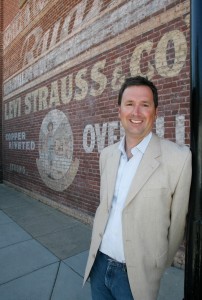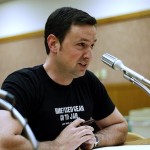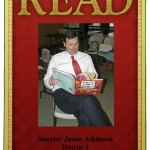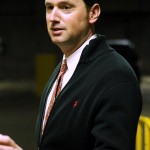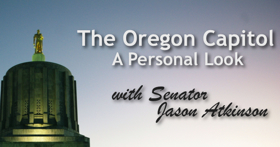Jason AtkinsonRecovering PoliticianTHEN: State Senator (OR), 1998-2012 NOW: Entrepreneur, Filmmaker, Writer Full Biography: linkAll right, I’ll admit it: I’ve always wondered what’s the deal with Wall Drug. Green stickers with old-fashioned white lettering stuck on muddy Subaru wagons and rusty Suburbans in ski area parking lots all across the Rocky Mountains and the Northwest. Driving from Pierce, S.D., west a few days ago, having been forewarned by hundreds of billboards lining the last hundred miles, just off the freeway, I was greeted by Wall’s 80-foot-long, concrete two-tone giant dinosaur, staring at me with its white light bulb eyes, entering the Wall Drug store vortex. Nickel coffee, touristy stuffed jackalopes and enough key chains and tee shirts to satisfy the most thirsty tchotchke devotee, alas, Wall Drug. The town of Wall, S.D., is the gateway to the Badlands National Park, which I’ve always wanted to see at sunset, and here I was, en route, driving my rent-a-wreck to Mt. Rushmore at the perfect time of day. Neither disappointed, sunset or the next morning coffee with the presidents. In fact, in person, Mt. Rushmore is so much more touching, emotionally, than that picture in Encyclopedia Britannica I grew up looking at. Patriotism wrapped in the natural environment of a perfectly run National Park. The four grand leaders of our country (George, Tom, Abe and “T.R.,” among friends) are much bigger in person than I expected. Maybe that picture and my childhood View-Master limited my expectations. Even the size of the rubble pile was captivating. That rubble being its own monument to the years of invested lives, determination and dynamite liberating these figures from the mountainside. They loom large in the pages of history and literally tower at Mr. Rushmore. All 50 states and territories are represented there, with their flags and dates admitted to the U.S. etched in stone. I grinned a little wider finding Oregon’s name in marble, telling myself how much better my state’s placement was than the other 49. Donning my Teddy Roosevelt hat with the pride of a child wearing mouse ears to Disneyland, I had my picture taken and posted it to Facebook, where my little grandmother in Sacramento gushed about me as if I were still a young boy and shared her pleasure in seeing Mt. Rushmore, even though she’s never been there herself. And isn’t that what protected lands provide Americans: the security that public parks and monuments are open, that our forests and rangelands are well-managed, even if you never get a chance to visit? Driving around Custer State Park looking for buffalo, which is downright exotic to a Northwesterner, I was trying to decipher how this year’s dwindling pheasant population is hurting South Dakota’s economy. I’ve chased wild pheasants all over Oregon, fulfilling the employment act to the retrievers who live with me, and on this trip, I was privileged to hunt with the Governor Daugaard and a smiling, deaf English Springer, aptly named “Hunter.” Sadly, this year in the Great Plains, the Governor had to call state leaders together to grapple with the effects of an unusually low wild bird population, and, therefore, unusually low out-of-state-hunter-tourist population. Well, at least they have one of the crown jewels in the National Park system.
A recent report, “Protected Lands: A Government-lite Approach,” is trying to reframe the issue and its economics. The policy’s premise is that keeping American’s public lands and National Parks open must be consistent with the long-term health of the parks and public land and be founded on a strong working relationship with local communities, as well. No more winners vs. losers, left vs. right, environmental vs. the communities near that environment. The theory is to create federal policy with sustainable economic benefits in both “gateway” communities and the nation as a whole, while preserving America’s natural heritage. I’m not too sure Wall Drug is the sort of gateway argued for, but Rapid City certainly is. As an Oregonian playing tourist, I was impressed how vibrant Rapid City is — hotels, restaurants, and full-scale Cabalas stores filled with out-of-state license plates. National parks are wonderful, and for many visitors, the only time they ever experience the natural United States. The concept of “government-lite” extends beyond just parks. I like to apply the concept to areas of our country where the public lands debate is still couched in terms of who has a job and who votes against local police levies. In Oregon, Forest Service and BLM ground was teased back and forth to the logging industry during the spotted owl wars of the 1980s. As a result, several counties are on the brink of bankruptcy today because their budgets were built on a federal payment for not harvesting trees. Oregonians in those counties know the short shrift of trusting their federal government and the all too familiar pain of living in hurting communities. There is a balance that has not been struck. Read the rest of… Contributing RP Jason Atkinson continues to pump out exciting and sometimes hilarious films about its adventures in the great northwest. Here’s his latest, “Spring Skwala,” a film featuring Jason, Jim Root and Ken Burkholder chasing Brown Trout on the Owyhee River during the Spring Skwala Hatch. Enjoy: An annual pilgrimage begins this week. Thousands of Americans are excitedly unpacking boxes from Cabelas and Orvis and planning to leave the office early. Fox News skipped over for the Weather Channel. The stock market turned off, topo maps unfurled. Politics and the center-right’s distrust of the federal government put aside while a battery of American-made trucks and SUVs head out onto public lands for the start of hunting season. In the West, the federal government is the single largest non-tax-paying landowner. This includes 53 percent of Oregon, 84 percent of Nevada, 45 percent of California, all owned and managed by the Feds — a landmass larger than much of the eastern seaboard. For decades, local counties with struggling schools, understaffed sheriffs departments and closing libraries have posed the question the federal government either prove they own the land or pay taxes. These sagebrush rebellions flare their heads every few years but rarely go anywhere, because circuit courts are packed by urban lawyers who have no idea what the modern West is really about. But the fact is simple, rural places adjust to federal land policy, whether on fire or not.
Public lands need to stay in public hands. And the folks who live and hunt on public lands are the long-term key to environmental protection. Caretakers in their own right, the hook-and-bullet community is active in protecting and managing herds, raising money to restore fish habitat, and changing the ethic from use-and-abuse to natural restoration. Just yesterday, in a school parking lot in southern Oregon, picking up my 5th-grader, Grandpa Skip Rheault told me: “We waited 37 years to draw that unit (a wildlife lottery system), and that was probably the best hunt the boys and I’ll ever have in our lives.” I didn’t have a chance to ask about his success before he stopped me, smiling broadly, adding, “We didn’t even take an elk. Saw a lot of cows and spikes, but we only wanted a 6-point or better. Just seeing those healthy elk was worth the wait.” Read the rest of… The Northwest’s rivers are swollen and unfishable except for one. Contributing RP Jason Atkinson and Shawn Miller rush to catch steelhead before a big storm hits. Here’s Jason’s latest short film chronicling the adventure, “Before the Storm”:
A perfect example of the radical middle is Long Island’s Great South Bay. A true grassroots movement from towns like — Babylon, Sayville, Bellport, Patchogue and a dozen others — want their bay back. For centuries, this bay produced oysters, finfish, and clams, providing livelihoods to thousands of families. Today, that world is all but gone, destroyed by over-harvesting, rampant over-development, along with the gross mismanagement of the bay and of Fire Island, the barrier beach forming the bay’s southern border. A laissez-faire approach to resource management led to a ‘tragedy of the commons.’ Until now, the issues faced by Long Island’s shorelines and Fire Island were addressed ‘top-down,’ with The Army Corps of Engineers literally drawing lines in the sand. When a storm washed away dunes on Fire Island, or breached the barrier, the solution was simple: pile more sand. Billions spent over the decades to defend the indefensible, with the baymen knowing all along their bay needed regular flushing the breaches and shifting sands provided. The bay needs clean ocean water to come in an out with the tide, regardless of who is in office. But money can move faster than sand, and after all, there were were summer homes with basements to protect. The Army Corps, like America itself, has been informed by the old rules of conservation, where man can supposedly bend nature to our will and still protect it. With Sandy, however, came “The Breach,” a place on Fire Island’s National Seashore where the ocean broke through to the bay where The Army Corps of Engineers had limited jurisdiction. They couldn’t, post-Sandy, go and fill it in as they had with two other breaches. Within weeks, locals began to see years of stagnation convert into clear water. Fish returned, clam growth accelerated, eelgrass started sprouting. Residents of the South Shore could see their past again — and just maybe their future. They rallied fiercely to defend the breach against Democrats like Senator Schumer and Steve Bellone, the Suffolk County Executive, who sought its immediate closure, for reasons having nothing to do with science and everything to do with politics. Buried on Long Island are an estimated 500,000 septic tanks seeping into its sandy soil and triggering brown tides, rust tides, red tides, and blue green algae, wiping out Long Island’s bays, rivers and ponds. The Brookhaven town dump, referred to locally as “Mt. Trashmore,” the only mountain seen from the bay, leach downhill into the water, too. Mainline conservationists have failed to convey to the larger public they have come to the point where Long Island is at the brink of an ecological collapse. The radical middle knows the problems we face are fixable, building clean bays and protecting our waters is not rocket surgery. The old way of thinking is that all environmental issues are organized vertically, mainly in one party. My friends on the extreme right would say ‘this is all an environmental conspiracy,’ whereas our supposed Democratic stewards have typically funneled money into the hands of the incompetent. Save The Great South Bay has focused on the local shared love of the bay transcending all party lines. No budget to speak of, no lobbyists, no lawsuits. Party lines, environmental left and Tea Party labels, no longer apply. Marshall Brown, Founder of Save The Great South Bay, strategically organized laterally around a shared concern, rather than preach to the vertical choir. The radical middle started getting the word out what was at stake and what could be. To date, no Army Corp bulldozer has driven on the strip of beach to fill the breach and once again choke off The Great South Bay. So how come an Oregonian is talking about Long Island? The reason is the radical middle does something we don’t think Congress is capable of: working for the good of America first. The Great South Bay is as important to Oregonians as preventing the Pebble Mine in Alaska is to Iowans. Conservation reflects who we all are as Americans. The radical middle is ahead; way head in fact, of our politicians. In essence, they are a better definition of public service than those making decisions with an eye on a lobby donation. Don’t blame politicians, they don’t know any different than the old way of thinking. Winners, losers, fear and loathing is how they get elected. This new conservation movement created along horizontal lines and reaching across to people, holds no victory for these types of leaders. How can you be a true environmentalist working with a Republican? How can you get reelected if people who share the same concern you do are not part of your party? Marshall Brown states inclusively: “This is our bay, our heritage.” While politicians are playing partisanship gridlock, Brown and radical middle Americans like him are leading. (Cross-posted at The Huffington Post) |
| ||
| Copyright © 2026 The Recovering Politician - All Rights Reserved | |||





